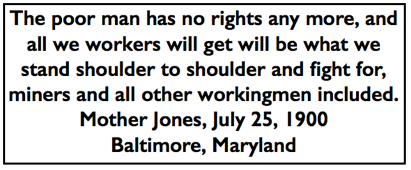 —————
—————
Hellraisers Journal – Wednesday January 27, 1904
Cheswick, Pennsylvania – Sorrow and Dread at Scene of Harwick Mine Disaster
From The Pittsburg Press of January 26, 1904:
—–
 —————
—————
Hellraisers Journal – Wednesday January 27, 1904
Cheswick, Pennsylvania – Sorrow and Dread at Scene of Harwick Mine Disaster
From The Pittsburg Press of January 26, 1904:
—–
 ———-
———-
Hellraisers Journal – Sunday September 9, 1900
Mother Jones News Round-Up for August 1900, Part I
Found Visiting Jailed Strikers of Georges Creek Coal District
From The Philadelphia Inquirer of August 5, 1900:
STRIKE LEADER GOES TO PRISON
FOR SIX MONTHS
——-
Woman Sympathizer Creates a Sensation
in a Maryland JailSpecial to The Inquirer.
CUMBERLAND, Md., Aug. 4.-William Warner, the strike leader, was sentenced this afternoon to six months in the House of Correction, having been convicted of unlawful assembly during trouble which arose at an anti-strike meeting. Seventeen miners were also sentenced. They were visited at the jail this afternoon by Mother Jones, the woman labor organizer, who created a sensation by proposing three cheers in the jail for the strikers and three hisses “for the blacklegs.” She led the cheering, as well as the hissing. Warner, who is from Pittsburg, took an appeal.
—————
[Photograph added.]
 ———-
———-
Hellraisers Journal – Tuesday November 18, 1919
Pennsylvania Cossacks, Steel Strikers, and Civil Liberty
From The Nation of November 15, 1919:
Civil Liberty in the Steel Strike
By MARY HEATON VORSE
THE steel strike has been marked by the orderliness of the strikers on the one hand, and on the other by the sweeping denial of their civil rights, and by the brutality of that extraordinary body of men, the State Constabulary of Pennsylvania. When one states that in Homestead, for example, there was a reign of terror, that men were beaten for no cause and chased down the street into strange houses; that men and women were arrested and fined for no cause and their fines remitted under promise that they would go back to work; and that posters fomenting race hatred are even now in current circulation in the steel mills, the statements sound fantastic. Let the documents, however, speak for themselves. One may choose almost at random from a wealth of material. The cases cited are not isolated; town after town had its own story of terrorism to tell.
In spite of Judge Gary’s statement to the contrary, men were persecuted and dismissed for union activities.
Not only were such methods used to discourage the men from organizing, but the rights of free speech and free assembly were denied them. No meetings were allowed in Farrell, Monessen, and Donora. In McKeesport people were arrested while attending a meeting and fined excessively. Rabbi Wise was refused a permit to hold a meeting in Duquesne, the burgess of this town remarking with naive truth: “Jesus Christ couldn’t hold a meeting in Duquesne.” Since September 22 [the date the Steel Strike began] no meetings have been allowed in Pittsburgh except at the Labor Temple. The strike in that city is unpopular with the authorities. Because the sheriff does not like Mr. Foster, he arbitrarily takes away the workers’ civil liberties, though at no time has there been even a suggestion of disorder in Pittsburgh.
Before the strike was actually in progress, the State Constabulary was called in and an extra police force of 5,000 was deputized in Allegheny County alone. Among these deputies were Negro strike breakers—in the towns of Donora and Monessen—and this during a time when an epidemic of race riots had swept the country.
 ———-
———-
Hellraisers Journal – Thursday November 13, 1919
Intimidation in Pittsburg Steel District Contrasted with Ohio
From The Survey of November 8, 1919:
Closed Towns
Intimidation as It is Practised in the Pittsburgh
Steel District:—the Contrast in OhioBy S. Adele Shaw
[Parts III-V of V]
III
THIS interlocking of mill and town officials explains not only the ease with which normal civil rights have been shelved, but the ease with which, under the guise of law enforcement, deputies and troopers get away with reckless action in the streets and alleys, and with which the petty courts turn trumped-up grounds for the arrest of labor organizers and strikers into denials of justice.
In Allegheny county Sheriff Haddock had, according to his own statement on October first, deputized 300 men for service under control of his central office and 5,000 mill deputies. Newspapers placed the figure early in the strike at 10,000. The mill police who in ordinary times are sworn in under the state provision for coal and iron police for duty in the mills only, are, since the strike, sworn in by the sheriff at the request of the companies. They have power to act anywhere in the county. They are under the direction of the mill authorities. Companies are required to file a bond of $2,000 for each man so deputized and are responsible for his actions.
It is the state constabulary, however, who have set the pace for the work of intimidation in the mill towns of Allegheny county. Responsibility for calling them in is difficult to fix. Since last February squads had been stationed at Dravosburg within easy reach of the steel towns; and the Saturday before the strike patrols were brought down into them. The sheriff denies that he called on the state for the troopers. The burgess of Braddock and the chiefs of police in Homestead and Munhall professed ignorance of the responsibility for their coming.
 ———-
———-
Hellraisers Journal – Wednesday November 12, 1919
Intimidation as Practiced in the Pittsburgh Steel District
From The Survey of November 8, 1919:
Closed Towns
Intimidation as It is Practised in the Pittsburgh
Steel District:—the Contrast in OhioBy S. Adele Shaw
[Miss Shaw spent the first two weeks of the strike in the Pittsburgh district for the SURVEY, and then crossed from Pennsylvania to the steel centers of Ohio, where civil liberties are preserved in the midst of the industrial conflict. A native of Pittsburgh, member of the staff of the Pittsburgh Survey, Miss Shaw brings experience as a social worker and as a journalist to her task of interpretation. The first draft of her article was submitted for criticism to public officials, strike leaders and mill executives. Facts were then checked up and incidents carried to their sources, and her narrative can be depended upon as the findings of a trained observer.—EDITOR.]
[Parts I-II of V]
I ARRIVED in Pittsburgh the evening of the third day of the steel strike [September 24th]. Through a gate to one side of me, as I stood in the Union Station, a line of foreigners perhaps twenty-five in number, Slavs and Poles, dressed in their dark “best” clothes, with mustaches brushed, their faces shining, passed to the New York emigrant train. Each man carried a large new leather suitcase, or occasionally the painted tin suitcase—a veritable trunk—appeared in the line. And there, not quite concealed by its wrapping, was the unmistakable portrait which one could picture in its setting over the mantle in the boarding-house just left. Men and baggage were leaving, as every night they leave from that station on that same train for New York and the “old country.”
Scarcely had the gate closed on the emigrant workers when a guard threw open an entrance gate through which marched, erect and brisk, a squad of state constabulary “Cossacks” they are called in the mill towns. Young men they were in perfect training—men with great projection of jaw developed, it almost seemed, to hold the black leather straps of their helmets firmly in place.
 ———-
———-
Hellraisers Journal – Sunday October 26, 1919
Report from Front Lines of Great Steel Strike by Mary Heaton Vorse
From the Duluth Labor World of October 25, 1919:
[Part I.]
MEN SHOW DOGGED ENDURANCE;
-EVERY RIGHT IS DENIED THEM
—–
State Troopers Serve Masters of Steel-Break up Meeting
-Search Homes Without Warrant-Override Children Playing
in Streets, But Men Are Determined to Win Out at Any Cost.
—–By MARY HEATON VORSE.
PITTSBURGH, Oct. 23.—(Special to The Labor World.)—The other day a man came in to Foster’s office. He had been on strike three weeks, and now he had about 90 cents left. He had some chickens, he had good neighbors, that had given him vegetables and things from their gardens. The man was a foreigner, a young married man, and what he had come for was not to ask strike benefits. He wanted advice and the moral support of encouragement.
He wanted to know how he was going to get along. He came rather deprecatingly, smiling in an embarrassed sort of fashion over his difficulties. Then he went away, still with his smile, his only assets his friends, his 90 cents and his indomitable will to stick out.
The strike is based on people like this; people full of faith; people full of endurance; people full of sacrifice—thousands and thousands of them.
Thousands of them looking upward and forward to a better life for themselves and their children—for these people are striking for a right to be considered as men. They are striking for the right of a little leisure. They want an end put to this de-humanizing double shift.
The other day in Braddock a mill superintendent stopped an old timer on the street. “Aren’t you working?” he asked.
“No, I am not working. I’m on strike; I’m taking a holiday. I am paying myself back those 20 Christmases I worked for the company,” said the man.
That has been the situation with the mill workers. No Sundays, no Christmas. Work that took it out of a man so that he was old at 40. Work that left him so tired at the end of a day that he wasn’t a human being any more. And now these people are willing to sacrifice to change this sort of thing, for themselves, for their children, and for the workers of all time.